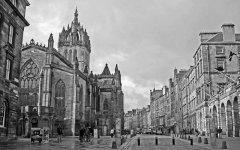squirrel$$$bandit
Veteran
OK, let me see what you think here. Just for the hell of it, I bought my Sigma DP1 to a friend's party last night, and shot in B&W jpeg mode. The DP1 is not known for its awesome jpg output, but I wanted to see if I could just pretend it was an RF with TriX in it, and see what I came up with.
I took this shot in low light at ISO400. It was underexposed, so I pushed it a couple stops and brought out some serious luminance noise. I increased the contrast and clarity in Lightroom. Then I sharpened the crap out of it, dimed the detail slider, turned off masking, and set the radius slider to 1.5. The first image below is the result; the second is the before and after in Lightroom.


OK, so, obviously, this does not look like film grain. But I have to admit, I really like it. It is definitely digital, and it is definitely noise, but it has a certain character. Like film grain, it's a natural artifact of the technology that created the image, and as such, I can't find a lot to hate. Even the jaggies on the wineglass don't bother me so much.
Am I nuts? Perhaps it's that I'm a child of the digital age, but I'm finding that digital noise, right out in the open, is no big deal. (I'm talking luminance here, not chroma, which I still think looks awful.) This has kind of been an evolving process for me, coming to like luminance noise in digital B&W photos. I've made a little preset for this, in fact, called "DP1 B&W jpeg," as a starting point for these quick-n-dirty snaps.
So what do you think? Am I a total philistine for liking this almost as much as film grain, or am I on to something?
I took this shot in low light at ISO400. It was underexposed, so I pushed it a couple stops and brought out some serious luminance noise. I increased the contrast and clarity in Lightroom. Then I sharpened the crap out of it, dimed the detail slider, turned off masking, and set the radius slider to 1.5. The first image below is the result; the second is the before and after in Lightroom.


OK, so, obviously, this does not look like film grain. But I have to admit, I really like it. It is definitely digital, and it is definitely noise, but it has a certain character. Like film grain, it's a natural artifact of the technology that created the image, and as such, I can't find a lot to hate. Even the jaggies on the wineglass don't bother me so much.
Am I nuts? Perhaps it's that I'm a child of the digital age, but I'm finding that digital noise, right out in the open, is no big deal. (I'm talking luminance here, not chroma, which I still think looks awful.) This has kind of been an evolving process for me, coming to like luminance noise in digital B&W photos. I've made a little preset for this, in fact, called "DP1 B&W jpeg," as a starting point for these quick-n-dirty snaps.
So what do you think? Am I a total philistine for liking this almost as much as film grain, or am I on to something?









